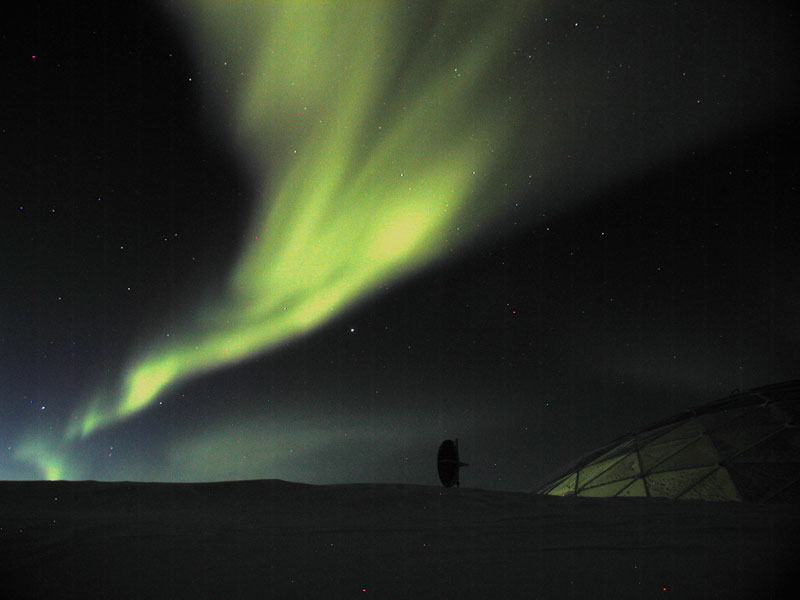
Aurora Australis reflecting off the dome at the South Pole April 20th

Aurora
Australis reflecting off the dome at the South Pole April 20th
April at the Pole - the light
show in the sky begins
April
is the month the pole transitions through civil twilight (sun is 0o-6o
below the horizon), nautical twilight (sun is 6o-12o below the horizon), astronomical
twilight (sun is 12o-18o below the horizon) and then official
total
darkness around the end of April. You can see a faint glow on the
horizon through much of the month of April when the horizon is very
clear. This glow rotates around the horizon every 24 hours. In average
conditions or when there are clouds, this glow is often not perceptible
and the sky appears totally dark after about the second week of
April. early
April twilight dome on april 1st
twilight under new
station south pole twilight
During
early April we also experienced many windy days with poor
visibility. flags to nowhere
snow covered SETI
telescope tower The back door
to my Cusp lab is getting harder and harder to keep clear now that is
is about 40 feet below the Antarctic plateau now. It requires a great
deal of back breaking work. Cusp back door after
several windy days door shoveled out
ice steps to warmth
from inside out
The dome entrance also gets drifted in now that it is not being dug out
any more drifted dome entrance
dome entrance
looking up from dome
exit And finally after walking almost a mile to
the VLF beacon building each day I frequently find a huge drift to dig
out just to get in the building VLF beacon drift
In early April we had some beautiful days with very clear skies, just a last hint of orange glint of twilight on the horizon where the sun is and temperatures around -80 F, winds...8-10 kts. The auroras were just starting to be visible then. I am able to usually tell when there is an aurora, because I set up some oscilloscopes and have my VLF receiver with an audio monitor so I can constantly monitor VLF and magnetic field signals on the oscilloscopes and listen for the sound of auroral hiss.... When I see and hear the correct signals, I usually check outside to make sure there is an aurora then I make an aurora alert on the station wide PA system.
It is
interesting here because in mid April, during nautical twilight,
you can just see the last hints of a glow on the horizon as that glow
moves
around you 360 degrees a day. Where you see the faint glow is where it
is about noon on that global meridian. For example, if you see the
faint glow at approximately the 0 degree meridian then you know that it
is noon on the Greenwich meridian (0 degrees) in England and midnight
opposite
that, at 180 degrees, or somewhere over the pacific.
The
moon is interesting too. It is up for two weeks and then down for two
weeks. You can figure out why by taking a couple of balls and drawing
on a rotational axis, then incline the "earth" ball about 23 degrees
from the horizontal or what would represent the ecliptic plane (orbital
plane of the planets around the sun) and visualize yourself at the
south pole and look at the moon, the other ball as it rotates about the
earth in about 28 days or four weeks. The orbit of the moon about the
earth is a few degrees off the ecliptic plane, so when the moon comes
up
here it spirals up for a week to a 23 degrees plus or minus a few
degrees and then spirals down for a week, then it is gone for two
weeks.
Also,
you can visualize the moon phases really well here when it is twilight
and you can see the glow of the sun below the horizon. When moon is
full,
the brightest part of twilight (or sun below the horizon) is exactly
180
degress across the horizon from the moon. When the moon is at the first
quarter or last
quarter, the brightest part of twilight (or sun
below the horizon) is
either 90 clockwise or counter clockwise from the moon. When the moon
is new, the glow is exactly under the moon. This phenomenon is now gone
as twilight is about over at the end of April.

Panorama of the South Pole on
April 6, during civil twilight. The first moonrise after sunset is
always a full moon. (scroll page to the right to see entire
panorama)
By
late
April the moon set and it was quite dark. The auroras and stars are now
beautiful, weather permitting. Photos of aurora are difficult to take
not to mention the frozen fingers and cameras and most photos don't
even come close to the beautiful visual experience you get when you are
really there, but there are a few shown here. aurora1 aurora2 aurora3
aurora4
aurora5
aurora6
And
finally, the south pole has a winter band this year and I am the
drummer. It is really great fun to play again after 33 years. We are
trying to have a gig about once a month up in the new galley. We play
mostly rock and roll from the 1960's up to some current tunes.
The band's name for the next gig is "The Dana Hrubes Comeback
Project" (not my idea) the band from the first gig
the rebirth of a
drummer from the late 1960's drummer
NEXT MONTH: The
darkness continues and temperatures continue to drop
A Real-Time Photo of South Pole Station as Seen from the ARO Building (live when satellite is up)
A Comprehensive
South Pole Web Site by Bill Spindler
Winterover Web Pages
(Bill Spindler's List)